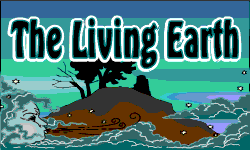The Living Earth
Created | Updated Dec 4, 2003

Flares, Eclipses, Impacts and Earthquakes
Over a year ago, I set up the Living Earth Society in H2G2 to keep track of natural events affecting our planet and to bring together people with an interest in the amazing processes affecting the world. After an initial flurry of enthusiasm, interest in the page died down, due in no small part to the fact that after changing jobs, I didn't have as much time to keep it updated. However, for the past three months, I have regularly added links to noteworthy stories and I have started again to keep track of events as they occur around the world. In brief - the Living Earth page is back in business! I am greatly interested in stories from H2G2 researchers - have you been ever been in an earthquake, a hurricane or a flood? Have you witnessed an Aurora or a meteor shower? Have you travelled to a place on Earth so marvellous, so spectacular in natural beauty, that you would like to drop me a line about it? If so, please come along to the Living Earth Page and let me know!
Last month, the focus of attention was less on terrestrial matters, and more on what was happening above us in space. The sun surprised us all with two of the largest sunspots ever seen on its surface at the end of October, and on no less than three separate occasions, explosions on the sun caused by these sunspots caused magificent auroras to occur in places they are rarely ever seen. The last aurora was on November 20th, and I was lucky enough myself to see the aurora display of October 30th - something I had never seen in my life before, and something that I will not forget too quickly. On November 5th a massive solar flare, by far the largest one ever witnessed, occurred in the viscinity of one of the huge sunspots. It had the force of billions of nuclear bombs and sent millions of tons of solar material racing into space. Had the Earth been in the way of this blast, its is likely that power grids across the planet would have shut down, and that many of our satellites would have been put out of action permanently. Only specialist telescopes picked up the event, as solar flares are impossible to spot from earth with normal vision, except during a solar eclipse.
Speaking of eclipses, we had two last month. There was an impressive total lunar eclipse (when the Moon passes into the shadow of the Earth) on November 8th, and a total solar eclipse (when the Earth passes into the shadow of the Moon) across the continent of Antarctica. Lunar eclipses are fairly common - most places will see one every 2 years or so, but total solar eclipses are very rare. Most people are lucky if they see one in their lifetime.
Another rare event happens when a chunk of rock from space hurtles through our atmosphere and hits the surface of the planet. Events like this happen every so often, but because most of the Earth's surface is uninhabited (either ocean, mountain, frozen waste, jungle or desert), and because these rocks are small, nobody is known to have been killed by one as yet. However, very very rarely, a big boulder hits the planet and then all hell breaks loose. Many people nowadays have heard of the meteorite impact 65 million years ago that polished off the dinosaurs. It was 10km wide, and it hit the planet with enough energy to completely blot out the sun for years. Around 70% of all animal and plant species were wiped out. Yet there was another extinction much earlier than this, 250 million years ago, that did even more damage - rendering 95% of all species extinct. It's cause is a source of massive controversy, but new evidence released last month indicates that this may also have been the effect of an even larger meteorite.
November was a quiet enough month for big earthquakes. They happened, of course, (and there was a huge mag. 7.8 earthquake in the Aleutian islands on November 17) but again for the same reasons as the previous paragraph, it is only when they hit a built up community that they make the headlines. An interesting story from November entailed a magnitude 9 earthquake over 300 years ago, which is detailed in ancient Japanese texts. The tsunami generated from this monster went right across the Pacific ocean causing incredible destruction to the North American seaboard.
Who knows what this month will entail? I have regular news updates on the Living Earth Page, and I would welcome a chance to hear your stories.

